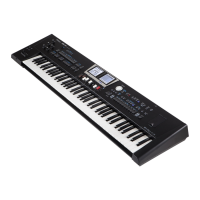103
22. Rhythm Composer
The BK-9 allows you to program your own rhythms.
Before explaining the details, there are a few concepts you need to
familiarize yourself with.
What are Rhythms?
Patterns (Divisions)
Rhythms are short sequences, or patterns (of four or eight
measures) you can select in real-time. Pattern-based
accompaniments usually consist of the following elements:
The basic groove, i.e. the rhythm that is the backbone of the
song.
Several alternatives for the basic groove that keep the
accompaniment interesting and suggest some kind of
“evolution” or “variation”.
Fill-Ins to announce the beginning of new parts.
An introduction and a closing section (ending).
Programming four to eight patterns for a three-minute song is
usually enough. Just use them in the right order to make them
suitable for your song.
The BK-9 allows you to program 54 dierent patterns per rhythm,
some of which can be selected via dedicated buttons (VARIATION
[1]~[4], etc.). Some Patterns are selected on the basis of the chords
you play in the chord recognition area of the keyboard (major,
minor, seventh).
Tracks
Unlike a drum machine, a BK-9 rhythm not only contains the rhythm
part (drums & percussion) but also a melodic accompaniment, such
as piano, guitar, bass and strings lines. That is why the rhythms work
with tracks – eight to be precise.
The reason why the AccDrums part is assigned to the rst track
and the ABass part to the second is that most programmers and
recording artists start by laying down the rhythm section of a song.
There are exceptions to this rule, however, so feel free to start with
any other part if that is easier for the rhythm you are programming.
NOTE
Though there are six (melodic) ACC tracks, most rhythms
only contain two or three melodic accompaniment lines. In
most cases, less means more, i.e. do not program six melodic
accompaniments just because theBK-9 provides that facility. If
you listen very carefully to a CD, you will discover that it is not
the number of instruments you use that makes a song sound
“big” but rather the right notes at the right time.
Looped vs. one-shot patterns
The BK-9 uses two kinds of patterns: looped divisions and one-shot
divisions.
Looped divisions: Looped divisions are accompaniments that are
repeated until you select another division or press [START/STOP] / [
*/, ]to stop Arranger playback.
The BK-9 provides four programmable looped divisions (VARIATION
[1]~[4]).
Looped divisions do not select other divisions when they are
nished (because they never end): they keep playing until you
select another division by hand (or by foot).
One-shot divisions: One-shot patterns (or “Divisions”) are only
played once and then select a looped division or stop the Arranger.
The BK-9 uses the following one-shot divisions: INTRO [1]~[4], FILL
UP [1]~[3], FILL DOWN [1]~[3] and ENDING [1]~[4].
The division type also determines how the respective tracks are
played back. Any track of a looped pattern that is shorter than
another track is repeated until the longest track is nished. Then, a
new cycle begins.
Here’s how you can take advantage of that: if the drums play the
same notes during four measures, while the rhythm guitar or piano
needs four measures to complete a cycle, recording only one drum
measure is enough, because it is automatically repeated until the
longest track is nished.
Several drum tracks are possible
The Rhythm Composer allows you to assign a Drum Set to any
“Accomp” track, thereby turning it into an additional drum track.
Starting to Make your Own Rhythm
The rst thing we need to do is clear the BK-9’s rhythm memory,
because it is not empty when you select the Rhythm Composer.
1. Press the [MENU] button, select “Rhythm Composer”, then
push the dial.
The displays change to:
Left Display
Right Display
2. Press the [QUICK MENU] button (its indicator ashes).
The left display changes to:
Left Display
3. “Initialize Rhythm” is already selected, so push the dial.
The display changes to:
Left Display
The settings shown on this display page are suggested as defaults
for every new rhythm you program.
Feel free to change them depending on the kind of accompaniment

